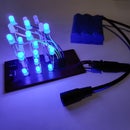Introduction: Maker Faire Invitation System
This project was created for an assignment while I was in high school in my grade 11 Communications Technology class. The objective had been to make a creative invitation to any event you wanted like a birthday, wedding, party, etc.
The way our teacher explained the project sounded like she was really pushing that the invitation should stand out to be deemed a good project. From that notion, I figured I had to do something with a screen in it to wow the masses so to speak. Since that year I'd recently taken apart a tablet from China which had stopped working and salvaged the screen; I had a possible answer to the call.
Step 1: Bill of Materials (BOM)
- Project Box
- Hot Glue
- HDMI Cable (preferably slim)
- 7" LCD Screen with 50 pin ribbon cable
- LVDS Driver Board
- 5.5*2.1 mm DC cable
- AA Battery (x4)
[since 18650s are pretty bulky/heavy, tried four eneloop 1.2V AAs for better voltage rating for the pi but would discharge too quickly even at 2000mah] - Raspberry Pi Zero (or any RasPi depending on space left in the box)
- Quad AA Battery box
- Heat shrink tubing
- Female HDMI to Male mini HDMI adapter
- Speaker 2W 8Ω (x2)
- Mercury/"Gravity" switch
- Class 10 8GB micro SD card
*Optional*
- HDMI to mini HDMI cable (slim) instead of a HDMI-HDMI cable and HDMI-mini HDMI Adapter
- Hall effect sensor instead of the mercury switch for safety issues
- Breadboard for testing
RGB LCD HAT for RasPi (instead of LVDS driver board, since with this being added to the market is less power demanding and cheaper than the LVDS board)
Step 2: Setting Up the Raspberry Pi Zero Audio
(You can skip this step if you are using a Pi w/an audio HAT or model with the 3.5 mm jack)
I had help configuring the audio and the guide I followed was this one from Adafruit. To a Raspberry Pi beginner with no coding experience or electronics/circuit theory, it was easy to understand and clearly written.
Step 3: Playing the Invite Video at Boot of the Pi
Not exactly sure what link I followed for this step (as it has been about three years), but this tutorial should suffice: https://bit.ly/2JTk06K. The general idea is that when the Pi boots, it searches in the path of your video file specified and uses the omxplayer to force it through the HDMI port.
In the future I may try extracting the bash file I used from Pi itself and post it here in case you guys run into issues editing your own bash files. But it's also because the linked script probably loops the video instead of playing it once to then leave the desktop wallpaper open for the invitee to see and RSVP of course.
Step 4: Assembly
To pull everything together you'll need a soldering iron and some solder. If you haven't soldered before here is a good video to get you going. The hardest part is probably fitting everything in the box rather than the soldering & assembly. So when opening the box have no fear, the video will appear :)
Step 5: The Final Result
As you can hear in the video the audio is pretty noisy and out of sync at times. The reason is since no audio amp was used the sound is fully dependent on the augmented audio generated through the Pi's GPIO so the output to the speakers is relatively low. So I increased the audio of the video file twice so the low-ends also go amped up, hence the crackling heard.
The video is a bit flashy since the LVDS driver board is taking <6V (the batteries aren't new in the demo vid).
You've reached the end of this adventure, thanks for your time and dedication to this build!











